
Introduction
Media reports
and certain environmental pressure groups claim that some man-made
substances interfere with the body's own hormones. They build up
in the body over time, often over years. These compounds find their
way into our bodies through a variety of pathways and cause adverse
health effects to humans and wildlife by interfering with the endocrine
system.
"A
wide range of chemicals called endocrine disrupters, which interfere
with the body's hormones, are suspected of causing behavioral problems
in children, possible brain damage and defects including abnormal
genitals. New data suggests a fetus is sensitive to [very small
amounts] parts per trillion of some of these chemicals. Across the
world, millions are being spent investigating this potential horror."
The Guardian, 1 July 1998
What is an endocrine disruptor?
Rachel Carson first highlighted the subtle impacts of chemicals in
our environment upon animals with her work on DDT in the 1950's and
60's. In recent years studies have begun to bring together the studies
showing clearly the impacts of man-made chemicals like PCBs, 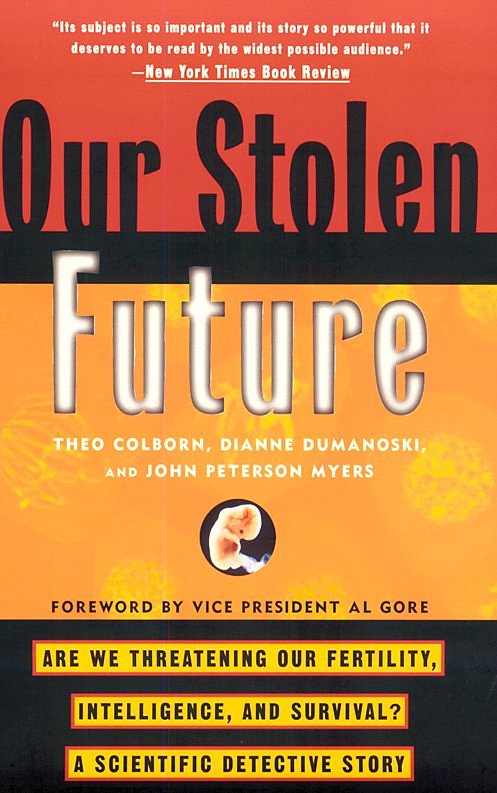 dioxin
and many pesticides that act like hormones and interfere with or disrupt
normal body functions exacerbating the development of breast cancer,
reducing sperm counts, interfering with normal development among other
health impacts. One book that describes these impacts is Our Stolen
Future: Are We Threatening Our Fertility, Intelligence and Survival?
by Theo Colborn, Diane Dumanoski and John Peterson Myers. dioxin
and many pesticides that act like hormones and interfere with or disrupt
normal body functions exacerbating the development of breast cancer,
reducing sperm counts, interfering with normal development among other
health impacts. One book that describes these impacts is Our Stolen
Future: Are We Threatening Our Fertility, Intelligence and Survival?
by Theo Colborn, Diane Dumanoski and John Peterson Myers.
Environmental chemicals pose the greatest hazard in the earliest
phases of life because hormones orchestrate development and fetal
development is exquisitely sensitive to tiny variations in hormone
signals.
For
a fetus to grow up according to its genetic blueprint, the right
hormone message has to arrive at the right place in the right amount
at the right time. The emerging science presented in Our Stolen
Future is about what happens when something interferes with the
delivery of that message. A signal doesn't arrive because it is
blocked. One that was small becomes large. One that shouldn't have
been there at all shows up nonetheless.
The endocrine system
utilizes circulating hormones to help integrate the functions of
individual organs and the nervous and immune systems. Complex interactions
among these systems are responsible for control, regulation, and
maintenance of homeostasis, reproduction, development, and behavior.
DDT was recognized to
have estrogenic effects in chickens in 1950. Though it is now banned
from use domestically, one ton of DDT per day passed through US
ports in 1996. Large quantities are produced and used elsewhere
in the world.
The effects of endocrine
disruptors also provides powerful evidence for why we must stop
exposure to chemicals such as dioxins, PCBs, DDT and other chlorinated
pesticides and industrial chemicals. PCBs and DDT have already been
banned from sale in this country, but PCBs can still be found in
virtually every neighborhood transformer and capacitor. And, DDT
continues to be manufactured for export to other countries. We need
to get involved to get government and industry to remove PCBs from
use in this country and to stop the manufacturing of DDT for export
and use in other countries.
Our historic concentration
on dioxin, PCBs, and DDT has produced a large volume of literature
relating to their toxicity. Even with these chemicals, there are
large gaps in our understanding of mechanisms of action. Most other
compounds, some of which are in widespread commercial use, found
virtually throughout the world, to which large populations of humans
and wildlife are exposed, have been studied much less or not at
all.
We are engaged in a large
global experiment. It involves widespread exposure of all species
of plants and animals in diverse ecosystems to multiple manmade
chemicals.
Between the 1940s and 1970s, doctors prescribed an artificial estrogen
named diethylstilbestrol, or DES, to prevent miscarriages in millions
of pregnant women. The
diethylstilbestrol (DES) story is,
of course, another tragic example of failure to understand the consequences
of human exposure to a hormonally-active substance. DES was given
to millions of pregnant women for over twenty years before its adverse
effects in DES daughters and sons were recognized and its failure
to do what it was intended to do was acknowledged. In the early
1950's, soon after human use of DES was initiated, investigators
performed a double-blind, placebo-controlled study on the therapeutic
value of DES during pregnancy. The study clearly indicated that
DES did not prevent spontaneous abortions. In fact, DES use was
associated with increases in abortions, neonatal deaths, and premature
births - and we now know of the wide range of other effects that
became apparent after birth. If the unusual malignancies had not
occurred and finally been recognized in young women, how long would
it have been before other adverse effects were recognized and attributed
to DES exposure?
 An ad for Grant Chemical Company's DES product (1955).
An ad for Grant Chemical Company's DES product (1955).
Many plants produce substances
that can mimic or interact with hormone systems in wildlife and
humans. The most widely studied are those substances that mimic
the female hormone estrogen. At least 20 of these estrogen mimics
have been found in some 300 plants, 43 of which are present in the
human diet. Referred to as 'phytoestrogens' or 'plant estrogens',
these have been detected in a wide range of legumes (soybean, field
beans); grains (wheat, barley and rice); vegetables (carrots, peas,
potatoes, broccoli), fruits (plums, apples, grapefruit), cooking
oils (sunflower, linseed) and drinks (coffee).
Analysis of human blood
and urine shows that only a fraction of the phytoestrogens that
we eat is absorbed by our bodies but if consumption is large enough,
the concentration may be sufficient to create a biologically relevant
response.
Overall, opinions vary
on the role of the phytoestrogens in health. When eaten as part
of a balanced diet, they seem to be safe and possibly, beneficial.
Studies on cancer incidence in various countries suggest that phytoestrogens
may help protect against certain cancers (breast, uterus and prostate).
On the other hand, eating
very high levels of some phytoestrogens may pose health risks. Reproductive
problems have been documented in laboratory animals, farm animals
and wildlife that eat very high volumes of phytoestrogen-rich plants
- for example, red clover - which contains phytoestrogens that are
also found in soybean products for human consumption.
Whether these effects
are important for humans is far from clear, though it seems unlikely
that many people will be exposed to quantities that are sufficient
to have a significant impact on reproductive success. Nonetheless,
a recent study from the UK has linked the incidence of male reproductive
abnormalities to exposure in the womb to the high phytoestrogen
content of their vegetarian mothers' diet. Further, the use
of cottonseed oil for cooking has been linked to a marked reduction
in fertility of heavily exposed human populations in certain Chinese
provinces.
As these examples show,
we cannot be complacent about substances that are commonly found
in the human diet. Indeed, natural chemicals are no different from
man-made chemicals. The important issue is the level of exposure
and, while modest quantities may be beneficial, excessive consumption
may give rise to adverse effects.
The evidence for endocrine disruption
It is well known that
numerous substances induce a hormonal type response at the cellular
level in laboratory tests but have no impact on an intact organism.
Notably, many of our everyday foodstuffs such as grains, legumes
and soya based protein induce such a response because they contain
so called "phytoestrogens" that for the most part, are not harmful
to humans or wildlife. Nonetheless, consumed in large enough quantities,
there is evidence that some phytoestrogens can induce both beneficial
and adverse endocrine related effects.
 Similarly,
some man-made chemicals demonstrate the same type of response in
the laboratory, but at normal levels of exposure have no impact
on human or wildlife health. Scientists generally agree that at
high doses, certain chemicals could interfere with the endocrine
system and harm humans and wildlife. However, in most instances
the necessary dose level would exceed the level required to produce
other toxic effects - effects that are already well understood and
regulated by controlling exposure to levels well below those required
to cause an adverse endocrine effect.
Similarly,
some man-made chemicals demonstrate the same type of response in
the laboratory, but at normal levels of exposure have no impact
on human or wildlife health. Scientists generally agree that at
high doses, certain chemicals could interfere with the endocrine
system and harm humans and wildlife. However, in most instances
the necessary dose level would exceed the level required to produce
other toxic effects - effects that are already well understood and
regulated by controlling exposure to levels well below those required
to cause an adverse endocrine effect.
Nonetheless, the possibility
that endocrine activity at the cellular level could be indicative
of potential to do harm, cannot be ignored and there is a need to
undertake more definitive testing with animals. Although there are
no agreed and validated tests to identify endocrine disrupters,
tests do exist for almost all the potential adverse health effects
(e.g. various types of cancer, reproductive defects and behavioral
abnormalities) - irrespective of whether the mechanism is endocrine
disruption or some other toxicological pathway.
Many scientists and some regulators believe that if the threat from
endocrine disrupters is real, then these existing tests would have
already highlighted the problem. Others express the fear that traditional
toxicological testing is inadequate for assessing the 'subtle' threat
posed by endocrine disrupters. They believe that adverse effects
on human and wildlife health may be experienced at much lower levels
of exposure - particularly through exposure of the fetus or during
early development.
In support of their arguments,
environmental pressure groups point to instances where the health
- particularly, the reproductive health of wildlife has been damaged
by exposure to high levels of hormone mimics. Although some of this
problem can be attributed to hormones from animal and human origin,
this has nonetheless raised the fear that some reported human health
trends could be the result of exposure to industrial chemicals and
pesticides.
The Endocrine System
The endocrine system
acts as the chemical messenger system for communication throughout
our body. The main purpose of the endocrine system is to control
and regulate body functions especially growth and development. This
is accomplished through hormones, potent, biologically-active chemical
messengers that in very small amounts can produce significant biological
effects. Hormones are released from the brain, thyroid, ovaries,
testes and other endocrine glands and then carries them through
the bloodstream to the target cells and organs where they activate
and regulate various functions.
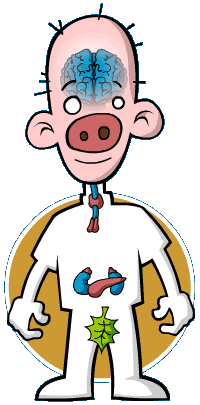 The
system is made up of the pituitary gland, which acts as a control
center telling the ovaries or the thyroid when to send their signals
and how much hormone to send. The pituitary gets its cues from another
gland, the hypothalamus, which acts as a thermostat telling the
pituitary to increase production, slow down or shut off. These messages
travel back and forth continuously to keep all parts of the organism
operating as one coordinated being.
The
system is made up of the pituitary gland, which acts as a control
center telling the ovaries or the thyroid when to send their signals
and how much hormone to send. The pituitary gets its cues from another
gland, the hypothalamus, which acts as a thermostat telling the
pituitary to increase production, slow down or shut off. These messages
travel back and forth continuously to keep all parts of the organism
operating as one coordinated being.
Hormones also guide the
growth of a baby's nervous system and immune system and "programs"
organs and tissues such as the liver, blood, kidneys and muscles
so they will function properly. During early development this regulation
of growth and development is critical for a child. The thyroid hormone,
for example, is essential for normal neurological function and development.
Deficiencies of thyroid hormones during fetal development or during
early infancy can lead to mental retardation, hearing loss and speech
problems. Children with thyroid deficiencies, even those with normal
IQ's, can have language comprehension problems, impaired learning
and memory and hyperactive behavior.
Chemicals
are now being identified that interfere with this critical system.
An endocrine disruptor is any substance that can interfere with
normal hormone function. Most are synthetic, fat soluble compounds
that are either pesticides or industrial chemicals. The pesticides
include chlorinated organic chemicals such as DDT, toxaphene and
kepone. Industrial compounds include PCBs, phenol and dioxins. Their
most common characteristics include persistence in the environment
and in organisms for long periods of time, and solubility in fats,
rather that water.
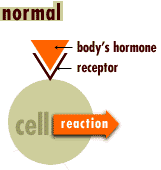
Normal hormone activates the receptor at the appropriate level
There are different ways
that these chemicals interfere with or disrupt normal hormone activity.
Three classes or types of disruptors have been identified:
mimics, blockers, and triggers.
Those that
"mimic" are chemicals that act like
normal hormones in the body. DES, the synthetic estrogen given to
women during the 1950's and 60's to prevent miscarriages, is a good
example of a mimic. Daughters of mothers given DES have an increased
risk of a rare cancer and
endometriosis. Sons born to mothers given DES have an increase frequency
of undescended testes, congenital birth defect, hypospadia, and
decreased adult sperm count.
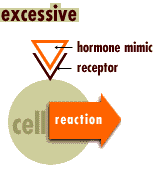
Hormone disrupters give a signal stronger than the body's hormone (and at the wrong time), or --
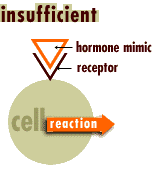 Hormone disrupter gives a signal weaker than normal, also at the wrong time.
Hormone disrupter gives a signal weaker than normal, also at the wrong time.
A second group of disruptors are hormone "blockers".
These interfere with how naturally occurring hormones function.
Blockers bind to the same protein receptors as the real hormone,
but do not stimulate any action. They just sit in the way of the
natural hormone and prevent it from
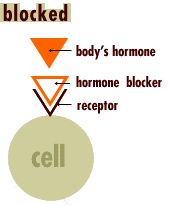 sending its message. An example of a blocker is how DDE (a metabolic breakdown
product of DDT) blocked
action of testosterone, in male alligators in Lake Apopka, Florida,
which led to undersized
penises. Testosterone, a male hormone is needed for proper reproductive
development in males.
sending its message. An example of a blocker is how DDE (a metabolic breakdown
product of DDT) blocked
action of testosterone, in male alligators in Lake Apopka, Florida,
which led to undersized
penises. Testosterone, a male hormone is needed for proper reproductive
development in males.
Hormone blocker interferes with the signal from the body hormones
"Triggers", the third category of
disruptors, include chemicals that interfere by attaching to protein
receptors but then trigger an abnormal response in the cell. These
triggers cause growth at the wrong time, an alteration of metabolism
or synthesis of a different product. The best known triggers are
dioxin and 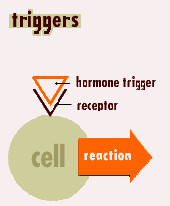 dioxin-like
chemicals. Dioxin acts through a hormone-like process to initiate
entirely new responses. dioxin-like
chemicals. Dioxin acts through a hormone-like process to initiate
entirely new responses.
Hormone disruptors intefere by triggering an abnormal response in the cell
1) The key hormones
The
endocrine system is a complex interplay between a number of hormones,
including the sex hormones the estrogens and androgens, and other
hormone systems such as the thyroid system. Estrogens such as estradiol
(structure below) are the hormones that influence the development
and maintenance of female sex characteristics, and the maturation
and function of the sex organs. Chemicals which can imitate an estrogen
are known as estrogenic chemicals. Androgens such as testosterone
serve a similar purpose in males.
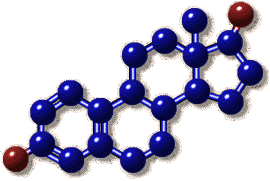
2) Other factors
There are many variables
which affect whether a hormone disrupting chemical has a biological
effect, including uptake, distribution, nature of action and time
of action.
3) The complexity of the endocrine, immune and nervous systems and human development
The development and functioning
of the human - and animal - body depends on a complex interaction
of chemicals, in which everything must happen at the right time.
Three crucial parts of
the human body are the immune system, the hormonal system and the
nervous system. It is easy to detect abnormalities in many other
parts of the body - if you break your leg, or are bleeding, it is
pretty obvious. Detecting changes in these systems is far harder.
This is one of the reasons that providing proof of harm to any of
these systems is difficult, unless the harm is very substantial
- e.g. the damage to the immune system due to HIV. These three systems
also affect each other, particularly during the development of the
body.
Many of the interactions
within and between these systems depend on fairly simple chemicals
- all potential targets for imitation by man - made chemicals.
The pharmaceutical industry
deliberately produces chemicals that affect these systems - the
chemical industry does it accidentally - Every chemical is potentially
a pharmaceutical.
|







 dioxin
and many pesticides that act like hormones and interfere with or disrupt
normal body functions exacerbating the development of breast cancer,
reducing sperm counts, interfering with normal development among other
health impacts. One book that describes these impacts is Our Stolen
Future: Are We Threatening Our Fertility, Intelligence and Survival?
by Theo Colborn, Diane Dumanoski and John Peterson Myers.
dioxin
and many pesticides that act like hormones and interfere with or disrupt
normal body functions exacerbating the development of breast cancer,
reducing sperm counts, interfering with normal development among other
health impacts. One book that describes these impacts is Our Stolen
Future: Are We Threatening Our Fertility, Intelligence and Survival?
by Theo Colborn, Diane Dumanoski and John Peterson Myers.

 Similarly,
some man-made chemicals demonstrate the same type of response in
the laboratory, but at normal levels of exposure have no impact
on human or wildlife health. Scientists generally agree that at
high doses, certain chemicals could interfere with the endocrine
system and harm humans and wildlife. However, in most instances
the necessary dose level would exceed the level required to produce
other toxic effects - effects that are already well understood and
regulated by controlling exposure to levels well below those required
to cause an adverse endocrine effect.
Similarly,
some man-made chemicals demonstrate the same type of response in
the laboratory, but at normal levels of exposure have no impact
on human or wildlife health. Scientists generally agree that at
high doses, certain chemicals could interfere with the endocrine
system and harm humans and wildlife. However, in most instances
the necessary dose level would exceed the level required to produce
other toxic effects - effects that are already well understood and
regulated by controlling exposure to levels well below those required
to cause an adverse endocrine effect.
 The
system is made up of the pituitary gland, which acts as a control
center telling the ovaries or the thyroid when to send their signals
and how much hormone to send. The pituitary gets its cues from another
gland, the hypothalamus, which acts as a thermostat telling the
pituitary to increase production, slow down or shut off. These messages
travel back and forth continuously to keep all parts of the organism
operating as one coordinated being.
The
system is made up of the pituitary gland, which acts as a control
center telling the ovaries or the thyroid when to send their signals
and how much hormone to send. The pituitary gets its cues from another
gland, the hypothalamus, which acts as a thermostat telling the
pituitary to increase production, slow down or shut off. These messages
travel back and forth continuously to keep all parts of the organism
operating as one coordinated being.



 sending its message. An example of a blocker is how DDE (a metabolic breakdown
product of DDT) blocked
action of testosterone, in male alligators in Lake Apopka, Florida,
which led to undersized
penises. Testosterone, a male hormone is needed for proper reproductive
development in males.
sending its message. An example of a blocker is how DDE (a metabolic breakdown
product of DDT) blocked
action of testosterone, in male alligators in Lake Apopka, Florida,
which led to undersized
penises. Testosterone, a male hormone is needed for proper reproductive
development in males.
 dioxin-like
chemicals. Dioxin acts through a hormone-like process to initiate
entirely new responses.
dioxin-like
chemicals. Dioxin acts through a hormone-like process to initiate
entirely new responses.
